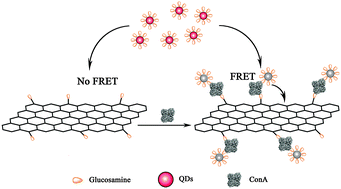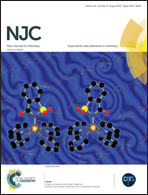A biosensing platform for sensitive detection of concanavalin A based on fluorescence resonance energy transfer from CdTe quantum dots to graphene oxide†
Abstract
In this paper, we constructed a novel fluorescence resonance energy transfer (FRET) system between CdTe quantum dots (QDs) and graphene oxide (GO) for sensitive detection of concanavalin A (Con A). In this system, CdTe QDs as an energy donor and GO as an energy acceptor were both covalently functionalized by glucosamine via an amide linkage. The specific combination of Con A with glucosamine could bring CdTe QDs and GO into appropriate proximity and therefore induce efficient energy transfer. The concentration of Con A caused modulation of the energy transfer efficiency between GO and QDs, thus enabling Con A detection. Under the optimized experimental conditions, the decrease of fluorescence intensity ratio I/I0 (I0 and I are the fluorescence intensity of the sensing system in the absence and presence of Con A, respectively) is proportional to the concentration of Con A in the range of 9.8–196.1 nM. This method has high sensitivity with the detection limit as low as 3.3 nM. The results suggested that the graphene FRET platform could be used for sensitive and selective sensing of Con A and could be applied for protein–carbohydrate interaction studies.


 Please wait while we load your content...
Please wait while we load your content...